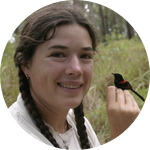About This Project
Mercury is a globally-increasing pollutant. At high concentrations it is a potent neurotoxin. However, we know relatively little about exposure to low levels of mercury. Here we will explore the effects of low-level dietary mercury (equivalent to a tuna fish sandwich) on sperm form and function in a common bird, the zebra finch. This will give us crucial insight in to how male fertility is affected by this increasingly common chemical, which has implications for medicine and conservation.
Ask the Scientists
Join The DiscussionWhat is the context of this research?
Human emissions of mercury are on the rise, largely through industrial activities related to processing fossil fuels and gold-mining activities. Because most of this mercury is released into the atmosphere, it can travel to almost anywhere on the planet. Once the elemental mercury is transformed into methylmercury by bacteria in waterways, the dangerous methylmercury can be ingested by organisms and build up in tissues to significant concentrations. As mercury accumulates in individuals over time, and because larger predators each lots of individual prey items, predators can quickly biomagnify the concentration of mercury. If we, or other species, eat those mercury-laden predators (e.g. tuna) then there can be health and environmental implications.
What is the significance of this project?
We are interested in understanding the health and environmental implications of consuming mercury at concentrations that you find in an average tuna fish sandwich--a level of exposure that is becoming increasingly common in the environment. This concentration of exposure does not cause immediately obvious effects--the organisms do not die--but our longer term project has already shown significant depression of breeding (40-50% reduction in offspring produced) at these levels. Overall, we know relatively little about how these sublethal concentrations of mercury affect organisms and, therefore, we intend to study the effects on male fertility. Studying mechanisms of fertility has immediate consequences for how populations persist in nature and for understanding effects on human health.
What are the goals of the project?
We will expose a well-studied bird, the zebra finch, to either a mercury or control diet (mixed in their food) and examine the consequences for sperm production and sperm form and function. By carefully manipulating male zebra finches you can get sperm samples, which we will analyze for total sperm counts, rates of malformations, and assess their swimming abilities with high-speed video. By having at least 30 males in both "mercury" and "control" groups we can assess the overall effects of mercury on these aspects of male fertility. The project will start in late summer 2017 and run through to the end of spring 2018. We intend to present the results at at least one international conference and publish the findings in journal articles and more informal Internet and video products.
Budget
Although we have a lot of the equipment and supplies for this project (e.g., aviaries for the birds and a Direct Mercury Analyzer to assess mercury in the food and the birds), we need supplies to keep the birds fit and happy ("bird food and care"), replacement catalysts to run our Direct Mercury Analyzer ("catalysts for mercury analysis"), and specialized microscope slides so that we can assess the speed and direction of swimming sperm ("microscope slides for sperm analysis").
Endorsed by
 Project Timeline
Project Timeline
By the end of summer 2017 we will have established our male birds, who have received mercury and control diets for their entire lives.
By fall 2017 we will obtain preliminary data on sperm counts and rates of malformations in the sperm. We will report these preliminary data to backers by December.
By the end of spring 2018, we will have complete sperm form and function data, including swimming speeds. We will report these data to backers and start to prepare the findings for publication.
Aug 04, 2017
Project Launched
Dec 15, 2017
Obtain preliminary sperm count data
Feb 14, 2018
Generate first sperm swimming videos
May 21, 2018
Obtain complete data set on sperm form and function
Meet the Team
John Swaddle
John and his research team study the effects of human-induced change of the environment on wildlife, mostly focusing on birds as they are great indicators of ecological health. He has been at William and Mary since 2001 and was previously a Royal Society of London University Research Fellow and has held many grants from the National Science Foundation. John has received several prestigious awards, including the Outstanding Faculty Award from the State Council for Higher Education in Virginia and the Outstanding New Investigator Award from the Association for the Study of Animal Behaviour. Together with his students, John has published near to 100 articles in journals such as Nature, Science, and Trends in Ecology and Evolution.
Project Backers
- 3Backers
- 1%Funded
- $59Total Donations
- $19.67Average Donation


